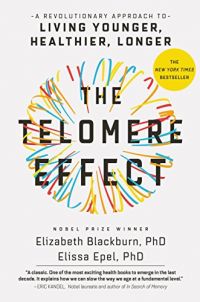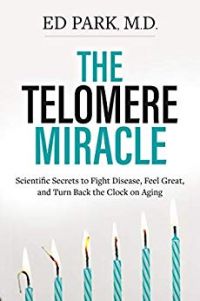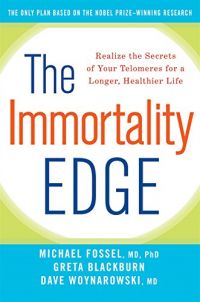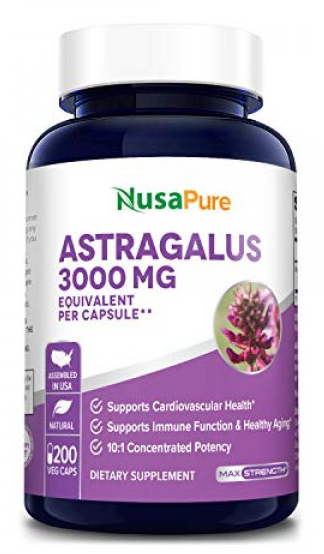Telomeres, the caps on the ends of your chromosomes, get shorter with each round of cell replication. Telomere length is one of the most accurate measures of biological age. Shorter telomeres are associated with aging and age-related diseases.

Telomeres Protect Your Chromosomes
Your DNA, which contains the codes for all the proteins and enzymes your body synthesizes for structure and function, are organized into compact structures called chromosomes. Each one of your cells contains 46 of these chromosomes, with millions of bases of DNA in each. Every time your cells divide, as happens when you grow and as you replace old, worn cells with new ones, your chromosomes lose a bit of DNA from their ends.1
To protect your important coding DNA from being lost, or from being damaged from other factors, your chromosomes are capped by stretches of DNA called telomeres. These telomeres contain repeating sequences of base pairs that are not important for coding, so the DNA loss that occurs with each round of cell division does not affect gene expression. Telomeres become shorter with age, and very short telomeres can lead to genomic instability and molecular disease.1,2

Telomerase Replenishes Telomere Length in Some Cells
A special enzyme called telomerase is able to extend the lengths of telomeres. In healthy cells, it is expressed in the highest amount in germ cells - the cells that give rise to eggs and sperm. This way, the telomeres that infants are born with do not become shorter with each passing generation. Telomerase is also expressed to a lesser extent in adult stem cells, allowing them to replicate a great number of times to keep replenishing cells lost to damage, disease, or general wear. However, the telomerase in stem cells is still not quite enough to fully prevent the shortening of telomeres, and eventually stem cell telomeres become short as well.1
Cancer cells have mutations that reactivate the telomerase gene, expressing telomerase at a higher amount than normal. This allows them to grow and divide rapidly and indefinitely, without eventually succumbing to shortened telomeres. Researchers are investigating how to use telomerase to extend telomeres and increase longevity, but in a way that avoids increasing the risk of cancer. Telomerase is also a potential target for anti-cancer therapies as well, since cancer cells depend on it for their continuous replication.1
Short Telomeres are Associated with Age and Disease
Short Telomeres are Associated with Age and Disease
Shortening telomeres are thought to be one of the main driving forces behind the aging process. Extensive research has shown that shorter telomeres are associated with higher rates of age-related symptoms and diseases. When stem cell telomeres become too short, your stem cells become instable and are unable to keep replicating. Thus, your body is eventually unable to keep replenishing cells in your tissues and organs, and they begin to fail as well.1
Some specific diseases have been linked to shortened telomeres. Short telomeres are part of the pathologies of aplastic anemia, pulmonary fibrosis, and liver disease. Mutations that cause telomeres to shorten faster than usual can cause these, as well as other disorders like immune deficiency.1
Shortening telomeres are thought to be one of the main driving forces behind the aging process. Extensive research has shown that shorter telomeres are associated with higher rates of age-related symptoms and diseases. When stem cell telomeres become too short, your stem cells become instable and are unable to keep replicating. Thus, your body is eventually unable to keep replenishing cells in your tissues and organs, and they begin to fail as well.1
Some specific diseases have been linked to shortened telomeres. Short telomeres are part of the pathologies of aplastic anemia, pulmonary fibrosis, and liver disease. Mutations that cause telomeres to shorten faster than usual can cause these, as well as other disorders like immune deficiency.1

Blood tests are an easy, non-invasive means of measuring biomarkers. Recently, tests for telomere length using a blood sample have been developed and made available to the general public. Since your red blood cells do not contain nuclei or genomic DNA, the test must be performed using your leukocytes (white blood cells). These tests use just a drop or two of blood, and cost around $100.
Doctors caution that “normal” telomere length at each age is a range. Therefore, the result you get from a telomere length test is only approximate.3

How to Protect Your Telomeres
Keeping in decent shape is a good way to slow the shortening of your telomeres in general. Reducing inflammation in your body can help prevent excessive cellular damage and telomere degradation. Eating antioxidant-rich and anti-inflammatory foods, avoiding environmental toxins, and reducing your psychological stress are ways to keep your body’s inflammatory processes down.4 Reducing the amount of calories you eat while still maintaining an adequate nutritional intake, known as caloric restriction, can also slow telomere shortening and biological aging.5
Exercise has been found to be a great way to keep your telomeres longer. In a study with identical twins, those who exercised more in their free time (outside of work) had longer telomeres than their more sedentary siblings. By exercising about three hours each week, you can prevent up to ten years’ worth of telomere loss.6
Keeping in decent shape is a good way to slow the shortening of your telomeres in general. Reducing inflammation in your body can help prevent excessive cellular damage and telomere degradation. Eating antioxidant-rich and anti-inflammatory foods, avoiding environmental toxins, and reducing your psychological stress are ways to keep your body’s inflammatory processes down.4 Reducing the amount of calories you eat while still maintaining an adequate nutritional intake, known as caloric restriction, can also slow telomere shortening and biological aging.5
Exercise has been found to be a great way to keep your telomeres longer. In a study with identical twins, those who exercised more in their free time (outside of work) had longer telomeres than their more sedentary siblings. By exercising about three hours each week, you can prevent up to ten years’ worth of telomere loss.6
Our Recommendation: In combination with caloric restriction diet & exercise, use an antioxidant-rich supplement to help support a healthy inflammation response and slow down telemere damage.
[1] Martínez P, Blasco MA. 2017. “Telomere-driven diseases and telomere-targeting therapies.” J Cell Biol. Apr 3; 216(4):875-887. https://www.ncbi.nlm.nih.gov/pmc/articles/PMC5379954/
[2] Kurzweil R; Grossman T. 2009. Transcend: Nine Steps to Living Well Forever. Rodale Inc., New York, NY.
[3] Vanchieri C. 2018. “At-home telomere testing is not a reliable marker of aging, researcher says.” ScienceNews. June 23; 193(11):4. https://www.sciencenews.org/article/home-telomere-testing-not-reliable-marker-aging-researcher-says
[4] Sadowska-Bartosz I, Bartosz G. 2014. “Effect of antioxidants supplementation on aging and longevity.” Biomed Res Int. 2014:404680. https://www.ncbi.nlm.nih.gov/pubmed/24783202
[5] Balasubramanian P, Howell PR, Anderson RM. 2017. “Aging and Caloric Restriction Research: A Biological Perspective With Translational Potential.” EBioMedicine. Jul; 21:37-44. https://www.ncbi.nlm.nih.gov/pubmed/28648985
[6] Cherkas LF, Hunkin JL, Kato BS, Richards JB, Gardner JP, Surdulescu GL, Kimura M, Lu X, Spector TD, Aviv A. 2008. “The association between physical activity in leisure time and leukocyte telomere length.” Arch Intern Med. Jan 28; 168(2):154-158. https://www.ncbi.nlm.nih.gov/pubmed/18227361
Search the blog
Article Categories
- All Articles (95)
- Rating Charts (1)
- Beauty & Skincare (17)
- FAQ (0)
- Hair Care (9)
- Health & Wellness (12)
- Anti-Aging (4)
- Kid's Health (0)
- Makeup (2)
- Men's Health (2)
- Oral Care (3)
- Sunscreen (7)
- Skin Tools & Treatments (10)
- Supplements (26)
- Videos (0)











